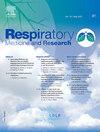高流量鼻吸氧治疗在COVID-19肺炎急性低氧性呼吸衰竭中的作用
IF 1.8
4区 医学
Q3 RESPIRATORY SYSTEM
引用次数: 0
摘要
背景:与常规氧相比,高流量鼻氧治疗(HFNO)可能改善急性低氧性呼吸衰竭(AHRF)的临床结果。然而,HFNO的使用是否能改善COVID-19肺炎的临床结果仍不清楚。在本研究中,我们描述了HFNO与传统氧疗(COT)在中重度COVID-19肺炎中的应用。方法回顾性队列研究于2020年3月1日至2020年7月14日在一家学术医疗中心和一家社区医院进行。本研究的主要目的是确定与COT相比,HFNO在预防有创机械通气(IMV)复合结局或院内死亡方面的成功。次要目的包括确定这一综合结果的预测因素、气管插管率、住院死亡率和早期与晚期HFNO衰竭的结果。采用逻辑回归和分位数回归来检验相关性。结果共纳入197例患者,其中HFNO组166例,COT组31例。两组间IMV和死亡的综合转归比较差异无统计学意义,优势比(or) = 0.36, p = 0.08。与COT相比,HFNO的使用与IMV发生率的显著降低相关(64%对87%,p = 0.03)。老年和冠状动脉疾病与HFNO衰竭有关。早期和晚期IMV患者的死亡率无显著差异。结论在我们的研究中,尽管我们发现与COT相比,HFNO与较低的插管率相关,但HFNO并没有降低中重度AHRF患者的IMV或死亡的主要综合结局。我们没有发现早期和晚期IMV的好处。在密切监测的情况下,对COVID-19合并AHRF患者应用HFNO可能是合理的初始呼吸支持策略。需要进一步的研究来确定这类患者中哪些能从HFNO使用中获益最多。本文章由计算机程序翻译,如有差异,请以英文原文为准。
The role of high flow nasal oxygen therapy in acute hypoxemic respiratory failure due to COVID-19 pneumonia
Background
The use of high flow nasal oxygen therapy (HFNO) may improve clinical outcomes in acute hypoxemic respiratory failure (AHRF) compared to conventional oxygen. However, whether the use of HFNO improves clinical outcomes in COVID-19 pneumonia remains unclear. In this study, we describe the use of HFNO, as compared to conventional oxygen therapy (COT), in moderate to severe COVID-19 pneumonia.
Methods
This is a retrospective cohort study conducted at one academic medical center and one community hospital between March 1, 2020 and July 14, 2020. The primary purpose of the study was to determine the success of HFNO in preventing the composite outcome of invasive mechanical ventilation (IMV) or in-hospital death compared to COT. Secondary objectives included determining the predictors of this composite outcome, rate of endotracheal intubation, hospital mortality and outcomes of early versus late HFNO failure. Logistic and quantile regression were used to test for associations.
Results
A total of 197 patients were included, 166 in the HFNO and 31 in the COT group. There was no significant difference between the groups in the composite outcome of IMV or death, odds ratio (OR) = 0.36, p = 0.08. Use of HFNO as opposed to COT was associated with a significant reduction in the rate of IMV (64 % versus 87 %, p = 0.03). Older age and coronary artery disease were associated with HFNO failure. There was no significant mortality difference between early and late IMV.
Conclusion
In our study, HFNO did not reduce our primary composite outcome of IMV or death in moderate to severe AHRF, although we found that HFNO was associated with lower rate of intubation compared to COT. We detected no benefit of early vs late IMV. Utilizing HFNO in COVID-19 patients with AHRF may be a reasonable initial respiratory support strategy with close monitoring. Additional studies are needed to determine subset(s) of such patients that would benefit the most from HFNO use.
求助全文
通过发布文献求助,成功后即可免费获取论文全文。
去求助
来源期刊

Respiratory Medicine and Research
RESPIRATORY SYSTEM-
CiteScore
2.70
自引率
0.00%
发文量
82
审稿时长
50 days
 求助内容:
求助内容: 应助结果提醒方式:
应助结果提醒方式:


